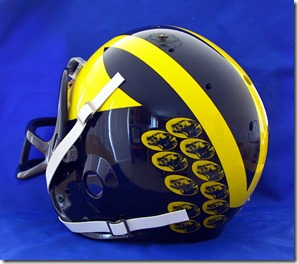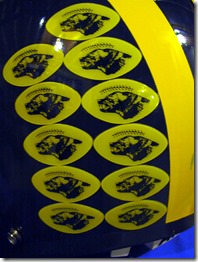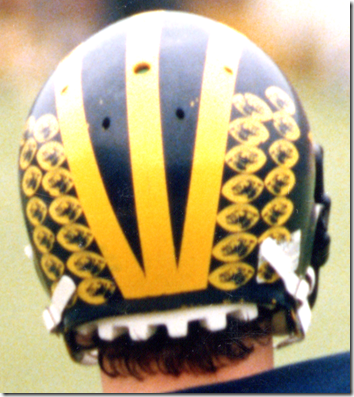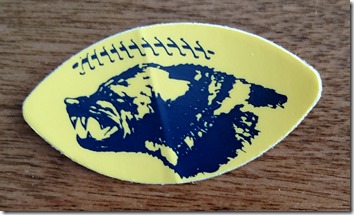
high-rez sticker courtesy Dr. Sap's Archives
[Ed (Seth) note: This article appeared in the 2010 edition of Hail to the Victors. Because they're bringing the stickers back, we thought to bring this article back.
Author John Kryk is all over the latest HTTV, with an original piece on the 1985 football team and an excerpt from his latest book Stagg vs. Yost: The Birth of Cutthroat Football, wherein Yost used horizontal offensive attacks and fast tempo to bewilder our chief rivals.
If you'd like to get our book, you have 4 days to get in on the Kickstarter.
If you'd like to get Kryk's book, it is scheduled to go on sale in mid-July and can be pre-ordered direct from the publisher.
A huge thanks to Dr. Sap and readers who sent in their pics of stickers.
Wolverines On Your Head
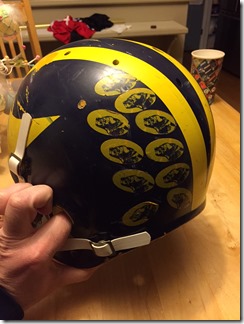 |
| Back of Derrick Walker's helmet from 1989, now in possession of reader Rob Graham. |
By John Kryk
When Jim Mandich, Dan Dierdorf and the '69 Wolverines dumped Woody Hayes' dream team, they sported reward stickers on the backs of their famous winged helmets.
So did Rick Leach when he led Michigan to two Big Ten championship victories in Ohio Stadium. And Anthony Carter when he caught that 45-yard lightning bolt from John Wangler against Indiana. And Jim Harbaugh when he crushed the Buckeyes back-to-back. And Leroy Hoard and Tyrone Wheatley when they ran roughshod in different Rose Bowl wins. And Desmond Howard when he made The Catch against Notre Dame, and when he struck The Pose against OSU. And Remy Hamilton when he gut-kicked Lou Holtz and the Irish.
But Michigan players' helmets haven't featured those maize, football-shaped reward stickers since Lloyd Carr took over for Gary Moeller in 1995.
It was a tradition begun at Michigan by Bo Schembechler in 1969. And, no, Bo wasn't copying Woody Hayes—as almost everyone today believes, especially the mouth-readers south of Lake Erie. The accepted story today is that Hayes’s 1968 Ohio State Buckeyes inaugurated the college football tradition of placing reward stickers on their helmets after each game. An ESPN.com feature story in 2008 reiterated that it “all started with those buckeye leaves.”
Only it didn’t. Guess who beat Woody to the punch, even within the state of Ohio? Why, none other than Bo. It was Schembechler, Hayes’s most famous pupil and eventual arch-rival, who’d begun the practice in 1965 at Miami University in Oxford, Ohio.
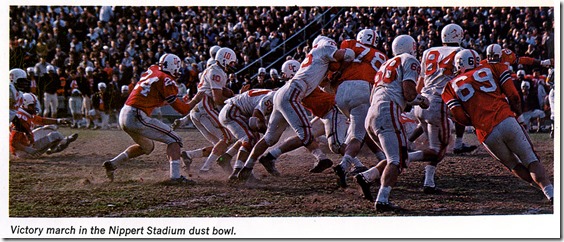
courtesy Miami University Libraries
[At the Jump: how the bird poo got on the Buckeye helmets, right before the guy who invented the stickers brought them to Ann Arbor]
Yes, it’s true that 1968 was the year when Ohio State changed its theretofore ever-changing helmet design to the now-familiar all-gray appearance — with white, black and red stripes down the middle. And, yes, it was in that same national-championship year that coach Hayes first started handing out the now-famous circular white reward stickers, each containing a drawn buckeye-tree leaf.
The next year, though, in 1969, Bo Schembechler took over the University of Michigan football team. At his Monday news conference following his first game — a 42-14 win over Vanderbilt — Schembechler explained that Michigan players would now be placing yellow, football-shaped reward stickers on their helmets after each game.
“Oh, like Woody?” a reporter asked.
“Uh-uh,” Schembechler grinned triumphantly. “Woody got the idea from me.”
Schembechler proceeded to tell the Detroit-area press that he himself had begun passing out such helmet stickers “a few years earlier” at Miami, his previous head-coaching job. He called it an “incentive program” to instill a feeling of personal pride in his players.
Dave Tsaloff, a two-time all-Mid American Conference guard who played under Schembechler at Miami from 1965 to 1967, remembers exactly when Redskins players started putting “big-play” stickers — little red tomahawks, to be precise — on their white helmets.
“In 1965,” Tsaloff said. “That was my sophomore year. I clearly remember it was that year, absolutely.”
Miami didn’t change its nickname to the more politically correct RedHawks until 1997, so in the 1960s tomahawks were seen as a proud representation of their Redskins heritage. Was the prospect of earning such a big-play decal an effective incentive for Miami players?
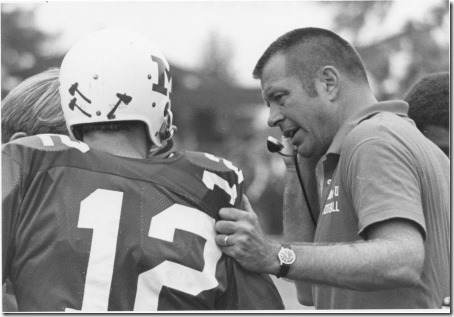
Miami University Libraries
“To have a tomahawk on your helmet? Hell, yes!” Tsaloff said. “Some of our players had their helmets covered in tomahawks.”
Curtis Worrell owns both Helmet Hut, a manufacturer of vintage pro and college football helmets, and HelmetHut.com, the Internet’s authority on the history of football headgear. Worrell not only confirms that Bo and Miami beat Woody and Ohio State by three years, but he says Ohio State wasn’t even the first Big Ten team to award helmet stickers.
“We know for sure that Wisconsin used the Badger award decals before 1966,” Worrell said, “and Dick Butkus and the guys at Illinois wore stars in 1964 — they added a star to their helmets for every huge play.”
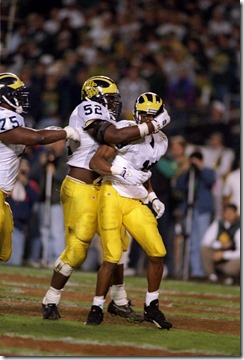 |
| A bestickered Rod Payne in the Holiday Bowl [Kryk] |
The ESPN.com story recycled the myth that credits longtime Ohio State team trainer Ernie Biggs for having first “conceived of the idea” of awarding helmet stickers. Hayes liked Biggs’s idea, the story goes, and that was that. But it seems implausible that Hayes, Biggs, or anyone else in the OSU football offices in 1968 would not have known that Schembechler had, for a few years, already been giving out such reward stickers to his players at Miami. Consider:
- Miami University is located in Oxford, just 125 miles west of Columbus;
- The Miami Redskins were often the second-best college football team in the state in the ’60s, so photos and film highlights of their games would have been prevalent in Ohio media, and in the coaching-film loop;
- Hayes would have paid special attention to Miami’s football exploits, as Miami was his previous head-coaching stop;
- Hayes and Schembechler were in regular communication from 1963 until the latter took over the Michigan program in ’69.
Whereas buckeye stickers have adorned Buckeye helmets since 1968, the tomahawk sticker tradition died at Miami long ago.
The tradition died at Michigan upon Carr's ascension to the top job. “What happened was they wanted to keep those individual awards private,” says Jamie Morris, star running back at Michigan from 1984-87. “Instead of putting stickers on their helmets, the team voted to keep it private, so that only their teammates would see them, on a wall chart.”
Schembechler himself had temporarily stopped the helmet-sticker practice at Michigan in both 1983 and 1984, but brought them back in 1985, and kept giving them out until he retired after the 1989 season. Gary Moeller continued the tradition all through his tenure as Michigan head coach, from 1990 to 1994. The last game in which Wolverine players wore helmet stickers was in the December 1994 Holiday Bowl, a 24-14 victory over Colorado State.
How did Schembechler determine how a player could earn a sticker?
How to Earn a StickerHere are the criteria Bo Schembechler announced on September 23, 1969 for determining how Wolverines would earn a helmet award sticker, according to a report the next day in the Ann Arbor News: ON OFFENSE 1) An outstanding block, catch or run ON DEFENSE 1) Pass interception |
Joe Novak, the retired longtime head coach at Northern Illinois, was a defensive end for Schembechler at Miami from 1964 to 1966. He remembers that the procedure was “very well-scripted. If you graded out at a certain percentage at your position, you’d get a sticker. Or if you recovered a fumble, or what have you.”
Said Tsaloff : “You could get more than one per game. If you made 15 outstanding plays in one game, you get get 15 tomahawks, theoretically. No one ever did, but you could.”
By the time he moved up to Michigan, Schembechler had instituted an elaborate system (see sidebar at right).
“The thing I liked about the way Bo gave them out was it wasn’t just for individual accomplishments,” Morris said. “For instance, if the offense got out of a huge hole, the whole offense would get one. Or, if you rushed for 200 yards, the whole offensive line got one too. Position coaches would all help determine who got the stickers.”
Decals were such a valuable commodity, Morris said, the Michigan players weren’t allowed to put them on their helmets themselves.
“No, it was the equipment manager. We’d come into the locker room and they’d already be on. These were valuable things. Bo strongly believed in players getting rewarded. It was all about rewarding the kids.”
While an Ohio State player fills up one side of his helmet with reward stickers before spilling them onto the other side, Michigan's maize footballs would be placed at the back and bottom of the winged helmet -- piling up, as the season progressed, on either side of the converging yellow stripes.
The look of the Wolverine reward decals changed over the years. There were three distinct versions, according to Steve Sapardanis [ed: you know him as Dr. Sap], a Michigan fan who is such an expert on Schembechler-era Michigan helmets, he recently went to incredible lengths to make an exact replica of quarterback Rick Leach’s 1977 helmet — almost.
Rick Leach's helmet (click for closer view)
The three helmet sticker versions used at Michigan were as follows, Sapardanis says:
(1) From 1969 through 1974: plain maize footballs.
(2) From 1975 through 1982, and 1985 through 1990: a wolverine head was added inside the maize football, and the ends of the footballs were rounded a bit. This wolverine-head design was taken from the wolverine animal logo that was so popular on Michigan apparel in the 1970s. There were two versions of this incarnation, with the wolverine head looking either left or right. Some Wolverine helmets had only the left-looking wolverine stickers going up the left side of their helmets, and right-looking ones up the right side. Most players’ decals, though, were a mix.
Jim Harbaugh's helmet, spring 1986 [Kryk]
(3) From 1991 through 1994: A year after Moeller took over as head coach, laces were added inside the maize football, just above the wolverine head — perhaps to underscore that these decals indeed represented footballs. This version can be bought on eBay, and are thus on the replica helmet.
courtesy reader Gretchen Nielsen
“To me, decals on football helmets ARE college football,” Sapardanis said. “The pros don’t have award stickers for great plays. Colleges do. Why? Passion. Enthusiasm. Emotion. Youthful energy. Spirit. These help to differentiate the college game from the pro game.
“During those old clashes between Ohio State and Michigan, what made the spectacle even more eye-catching to me was the decals on BOTH teams’ helmets. They just added to the color and pageantry of the rivalry. Like military stripes or badges, the decals showed everyone that YOU were doing your part to help the team succeed. You were pulling your weight. You were helping the team to attain goals. You were making the sacrifices. You were a warrior.”
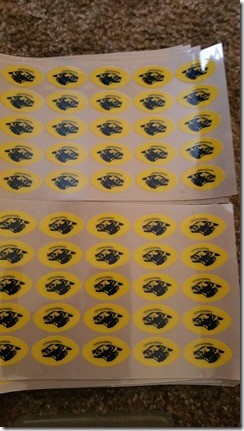 |
| Reader Meals69 got one of these at a Michigan football camp when he was in high school. He now sells them on eBay. |
Sapardanis, like many Wolverine fans of his generation who grew up on Schembechler option football, would love to see Rich Rodriguez bring the award decals back. After all, it wouldn’t be as though Michigan was copying Ohio State — as so many Michigan fans believe today. And the decals serve a useful purpose, as Schembechler discovered some 45 years ago.
“I think the decals demonstrate and effectuate team unity,” said Sapardanis, a Macomb resident. “Players will want to be noticed as having a team decal on their helmets. These decals unite the team AND the cause.”
Morris agrees.
“Are you kidding me? I loved those wolverine helmet stickers!” he said. “That was another reason I wanted to come here in the first place. I loved the Michigan helmets, and I loved the stickers on those helmets. I was sad to see them go.”
Said Miami’s Novak: “Those stickers instilled a great sense of pride. It was like wearing a badge of honor. Every time you made a great play, everyone knew it because it was represented on your helmet. Some coaches worried that reward stickers gave the other team a target of who to go after in a game. But it was a fun thing for players. Coaches are always looking for those kinds of things.”
While Schembechler, like Hayes, might not have been much of an X’s and O’s innovator — few perfectionist head coaches are — he can take credit for having helped to start the trend that today sees buckeye leaves on Ohio State helmets, tomahawks on Florida State helmets, dog bones on Georgia helmets and, now, even tiny white S’s on Michigan State helmets.
Tsaloff, for one, is proud to be able to help see that Schembechler is rightfully recognized.
“Considering all the headaches I gave Bo as a player, this is the least I could do for him,” Tsaloff said.
